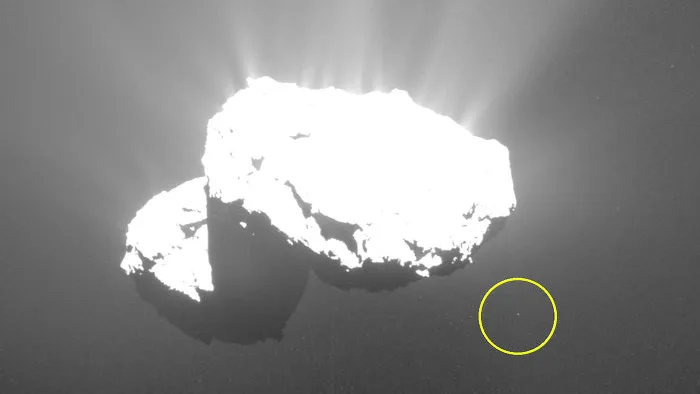
Say hello to 'Churyumoon', Comet 67P's newly-discovered companion
What's Up In Space? Rosetta's comet has a tiny companion, another asteroid threat ruled out, but something BIG hit Jupiter!
When the European Space Agency's Rosetta spacecraft was making headlines a few years ago, showing us spectacular views of the immense comet 67P/Churyumov-Gerasimenko, there was something there that everyone missed.
It seems we were so focused on Rosetta's tiny companion, the Philae lander, that we didn't notice that Comet 67P had a companion of its own!
This smol fren of 67P/C-G is now known as a 'Churyumoon', thanks to ESA researcher Julia Marín-Yaseli de la Parra.

This image was snapped by Rosetta's cameras on October 21, 2015, when the spacecraft was 400 km away from the comet. The circle shows the tiny 4m wide Churyumoon as it orbits the larger parent body. Credit: ESA
According to the ESA: "The sizeable chunk in this view was spotted a few months ago by astrophotographer Jacint Roger from Spain, who mined the Rosetta archive, processed some of the data, and posted the finished images on Twitter as an animated GIF. He spotted the orbiting object in a sequence of images taken by Rosetta’s OSIRIS narrow-angle camera on 21 October 2015. At that time, the spacecraft was at over 400 km away from 67P/C-G’s centre."
Check out more about this story, along with an animated sequence of the Churyumoon's orbit, on the ESA website.
SAFE FOR ANOTHER CENTURY
Astronomers were understandably a little anxious about house-sized asteroid 2006 QV89, up until now, but they've finally ruled out any impact from this object.
When it was discovered nearly 13 years ago, astronomers were only able to track this 30-metre wide space rock for a short time before they lost sight of it, and what they did see was a little bit unnerving.
According to the University of Hawai'i at Mānoa: "2006 QV89 was discovered on August 29, 2006, with a telescope in Arizona, and observations were only possible through September 8, 2006, when the asteroid became unobservable from telescopes on Earth. The orbit determined from these limited observations had significant uncertainty, and it was not possible to rule out the low probability of the asteroid impacting Earth in the future, possibly as early as 2019. Last month, observations with the European Southern Observatory’s Very Large Telescope (VLT) in Chile did not find the asteroid where it would have appeared if it was on a trajectory that would impact Earth this September. This ruled out an impact in 2019, but an impact for 2020 remained a possibility, along with nearly two dozen more over the next hundred years, with eight of those in the next decade."
At 30 metres wide, 2006 QV89 hitting Earth would have likely a similar impact as the February 2013 Chelyabinsk asteroid strike - a bright flash and a bang loud enough to shatter windows. However, that's if the asteroid is made of relatively soft stuff.
If it was, instead, an iron asteroid - the remnant of the iron-nickel core of an ancient fragmented planetoid - it could potentially be a city-killer, destroying buildings and more with a blast wave equivalent to an 18 megaton nuclear bomb.
Fortunately, once the Canada-France-Hawaii Telescope started up operations again this past weekend, astronomers there quickly acquired this asteroid and their observations allowed them to refine the orbit of the object.
As of now, they have completely ruled out any potential impact with Earth for the next century.
SOMETHING BIG SLAMMED INTO JUPITER
When you're one of the biggest objects in the Solar System, it stands to reason you'd get bumped into a lot. While watching the Perseid meteor showers on August 6, amateur astronomer Ethan Chappel captured just such a 'bump', as his telescope spotted a bright, white flare on Jupiter.
While the event still needs to be confirmed by reviewing data from other astronomers, Bob King of Sky & Telescope said some signs did point to an impact.
"It expanded from a pinpoint to a small dot before fading away," said King, "telltale signs of a possible impact based on previous events observed at Jupiter."
Given the size of the flare and the size of the planet, if it was a asteroid strike, the asteroid must have been fairly large to produce such a noticeable flash.
Come back next Tuesday for more What's Up In Space!
Sources: ESA | University of Hawai'i | Sky and Telescope
